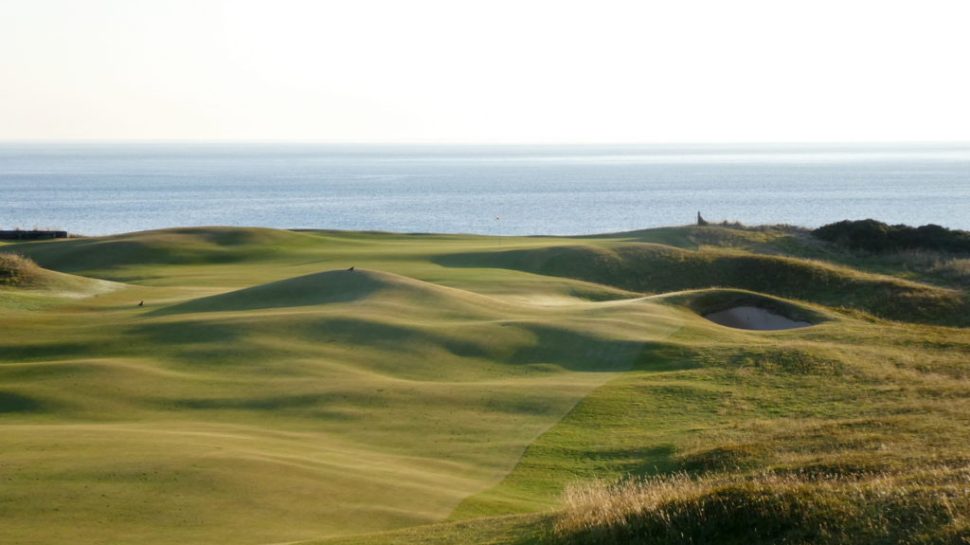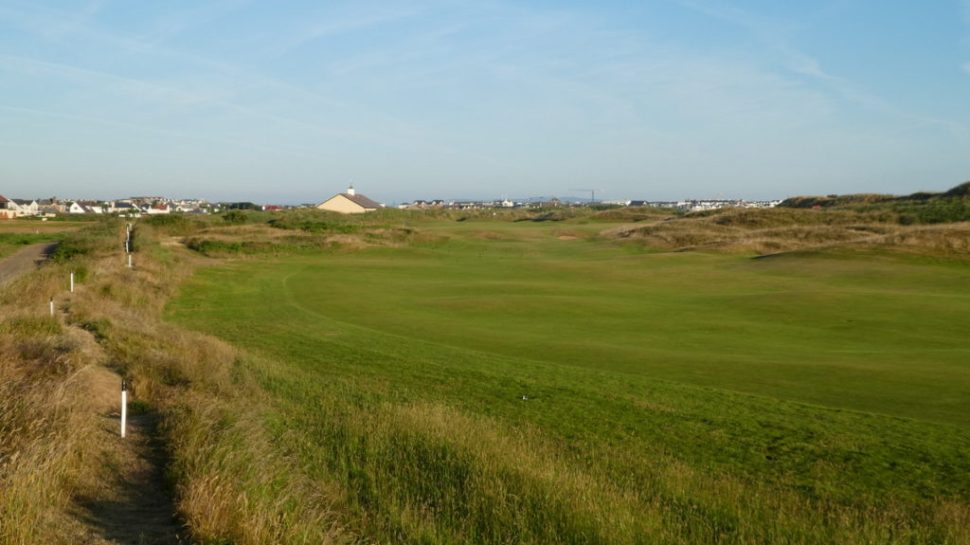When the opening tee shot is hit this Thursday at Royal Portrush it will mark the start of golf’s oldest major championship — played for just the second time outside of Scotland and England.

The Dunluce Links at Royal Portrush has been upgraded by architect Martin Ebert and the world’s finest players will encounter a 7,344 yards layout playing to a par of 71.
The nature of links golf presents numerous challenges to overcome. The mercurial weather is always a consideration. As are the unpredictable bounces, both good and bad, that can happen during the course of play. Constant adjustments are elements players will always need to focus upon.
While the Dunluce Links at Royal Portrush has always been noted as one of the great golf courses in the world – the stature and overall visibility from hosting The Open Championship will undoubtedly raise its considerable profile even more so.
Ebert has identified five (5) key holes on the Dunluce Links at Royal Portrush and explains his rationale on the significant impact each will have in determining who will ultimately hoist the famed Claret Jug at the conclusion of play.
Who is Martin Ebert?
A career in golf became my goal following a year long organization of the Cambridge University Golf Club’s tour to the United States in 1989, the year of the 100th Varsity Match between Oxford and Cambridge. It was a privileged experience to have visited such a great array of the traditional, old courses and clubs of the northeast United States and it reinforced my views of how golf courses should be eased into the landscape. This appreciation had been forged from playing many of the great seaside links and inland courses of the UK with the Cambridge team.

Golf at university was mixed with studying Engineering, firstly to gain a degree but this was followed by a postgraduate year with the main advantage being another year of golf. However, the engineering discipline proved to be extremely useful in supporting the drawing skills and technical abilities required of a golf course architect. Even with the most accurate plans though, the communication of ideas between the architect and shaper is the key to obtaining the best results.
Donald Steel offered me a welcome opportunity to assist him with the design of courses around the world in 1990. That has led to fascinating working experiences in 18 countries.
Membership of Woking Golf Club provided an education in the field of golf course architecture. In the early 1900s, Stuart Paton and John Low had turned the course from an ordinary heathland layout into a strategic classic with some wonderful greens inspired by the Old Course at St. Andrews. I am also a member of the Royal & Ancient Golf Cub allowing me to make regular visits to the Home of Golf, Royal Worlington & Newmarket Golf Club, with its timeless nine hole course, Askernish Golf Club, Royal Cinque Ports Golf Club, the Hawks’ Club, the Oxford & Cambridge Golfing Society, the Cambridge University Stymies and The Dinner Match Society in the United States.
***
5th Hole – “White Rocks” / Open Length – 374 yards, Par-4

Enjoys such a stunning backdrop and its green teeters on the edge of the cliffs which has a large part to play in its great popularity but also adds to its danger with out-of-bounds lurking just beyond it. Some of the longest hitters can look to drive or get close to the green on this downhill par 4 despite it measuring just 374 yards. In last year’s Boys Amateur Championship, one unfortunate competitor drove the green but just too far and it went out of bounds. After laying up with his second tee shot, he thinned the next out of bounds as well! An ugly 8!
In fact, the old back tee, which made the hole just over 400 yards, was removed so that the hole is driveable in the right conditions. Great short par 4s need some bite as well as opportunity but the landing area for long drives widens and previously not one bunker defended the hole although old photographs do show a greenside bunker. Two bunkers have been added to the landing area although these have relatively little impact upon the club golfers’ tee shots.
The better golfers should have some doubt in their mind when they are standing on the tee. If any of the bunkers are found, a bogey or worse could result. Another wonderfully shaped green at the end of the hole with a great variety of flag positions available.
8th Hole – “Dunluce” / Open Length – 434 yards, Par-4

The sight from the tees of the new 8th hole presents one of the ultimate challenges in golf. The steep dune bank running all of the way down the left side of the hole tempts the best players to bite off as much as they can to leave the shortest and simplest approach to the green. Plenty of fairway is available to the right but the hole is far more demanding if a less aggressive line is taken.
Second shots could range from 200 yards to 50 yards depending on what strategy is adopted. The dune land of the fairway has been softened in contour but the natural shapes have been used for inspiration. After the 8th hole, the Open competitors will walk through the Players’ Tunnel to the 9th tee. This has been specially built for The Open and will also take the players from the 10th green to the 11th tee.
11th Hole – “P.G. Stevenson’s / Open Length – 474 yards, Par-4

The second of the holes added in 1939, the conception of the Club Professional at the time, P.G. Stevenson, is a significant test as a par 4 rather than a par 5 as it is played by the Club. Hence it will be played as a two shot hole for The Open.
The drive is fearsome through the dunes with only a perfectly struck shot having a chance of finding the fairway. The penalty for missing the fairway will be severe and the average score for the hole is likely to be one of the highest relative to par if the normal wind blows. The approach shot has to be carried all of the way to the green defended, as it is, by a steep slope in the approach.
17th Hole – “Purgatory” / Open Length – 408 yards, Par-4

A back tee has been added to make it a little tougher to get the drives running down the steep slope towards the green. The hole has become a little easier to play over the years given the distance that the modern players are able to hit the ball. This has led to the addition of a bunker to the left of the fairway at the bottom of the steep slope.
That will put a little doubt regarding the strategy to be adopted but care has been taken to ensure that only drives pulled slightly left of the ideal line will suffer the fate of ending up in the bunker. If the bunker is found, or the tough rough on either side of the hole, a bogey or worse could result but perfect drives could finish very close to the green so eagles are on the cards.
So the 71st hole of The Open could see a huge swing of fortune. However, if the wind means that the golfers cannot reach the downslope in the fairway, a blind second could result and the wind shooting up the steep bank of the fairway can play havoc with the flight of approaches. Another great green with some excellent opportunities for flag positions which will test the accuracy and nerve on even the shortest pitch shot.
18th Hole – “Babington’s” / Open Length – 474 yards, Par-4

The old 16th hole makes a fine finishing hole for the course and The Open. A new back tee will put some doubt into the minds of the best players about whether to lay up or not. The historic out of bounds to the left of the hole — land which the Club previously did not own, hence the out of bounds — will be a threat if the driver is taken but, if the players choose to lay up, a long and possible blind second will result.
The fairway has been narrowed on the right to make the bale out option a less attractive one. The hole is another with a bold dogleg shape formed from the natural dunes, to the right in this case. The green is well protected by the deep bunker at the front right and the beautiful links bank to the left. It will be a fantastic scene with the green surrounded by grandstands for The Open!
All photos courtesy of Mackenzie & Ebert
